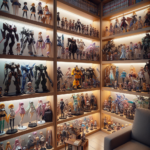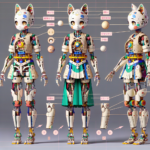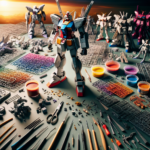Key Takeaways: Preserving Anime Figure Vibrancy
- Avoid exposing your figures to sunlight, which causes yellowing due to UV radiation.
- Use LED lighting for display areas to prevent paint fading.
- Invest in UV protective display cases to shield your figures from harmful rays.
- Control temperature and humidity with climate management tools like dehumidifiers and silica packs.
- Clean your figures regularly with the right materials to maintain their pristine condition.
Combat the Yellow: Must-Know Causes
Most importantly, understanding the reasons behind the yellowing of anime figures is key to prevention. It’s not just about keeping them out of the sun; it’s about knowing the invisible threats too. So, let’s dive into what turns your treasured collectibles that dreaded shade of yellow.
Identifying the Yellowing Culprits
It’s common knowledge among collectors that UV light is the main villain in the yellowing of anime figures. But did you know that even the type of plastic can play a role? Certain plastics contain fire retardants that can cause yellowing when exposed to UV light. Therefore, it’s crucial to understand both the environmental and material factors at play.
Here’s a quick rundown of the usual suspects causing your figures to yellow:
- Sunlight: The UV rays in sunlight are the most potent factor in yellowing figures.
- Fluorescent lights: These emit lower levels of UV radiation, but over time, they can still contribute to the problem.
- Heat: High temperatures can accelerate the degradation process of the materials.
- Oxygen: Exposure to oxygen can lead to oxidation, which is a fancy way of saying your figures can get ‘rusty’.
Distinguishing Between Environmental and Material Factors
So why do some figures yellow faster than others? It boils down to the materials used in manufacturing. Some plastics are more prone to yellowing, especially if they’re not treated with UV inhibitors. Besides that, environmental factors like the climate in your area and where you place your figures in your home can speed up the yellowing process.
Shading Your Collectibles: Positioning and Light
Where you place your figures and the type of light they’re under can make a world of difference. Sunlight is the natural enemy, but artificial light sources can be just as harmful if they emit UV radiation.
Optimal Placement to Avoid Sun Damage
To keep your figures safe, keep them out of direct sunlight. It’s tempting to place them where the sun can shine on them and highlight their features, but the UV rays will do more harm than good. Instead, find a spot that’s well-lit but away from windows or consider using curtains or UV blocking film on windows to minimize exposure.
Choosing the Right Lighting for Display Areas
When it comes to lighting up your display, LED lights are your best bet. They emit very little UV radiation and produce less heat, making them safe for long-term display. Here’s a simple guide to help you choose:
- LED: Low UV radiation, low heat, energy-efficient – the top choice for lighting displays.
- Incandescent: High heat, not ideal for close proximity to figures.
- Fluorescent: Emits UV radiation, not recommended for lighting figure displays.
Shield and Protect: Cases and Coatings
Even if you’ve got the positioning and lighting down, adding an extra layer of protection can significantly extend the life of your anime figures.
The Pros of UV Protective Display Cases
UV protective display cases are like sunscreen for your figures. They block out harmful UV rays, preventing yellowing and keeping your figures in mint condition for years. Plus, they offer an added barrier against dust and accidental damage.
Exploring Protective Coatings and Paint Care
Some collectors swear by protective coatings to keep their figures looking fresh. These coatings can provide a shield against UV light and prevent paint from fading. Just make sure to use products specifically designed for collectibles to avoid damaging the figure’s material.
Climate Control: Temperature and Humidity
Temperature and humidity control is crucial for preserving your figures. High heat can warp the plastic, and excessive humidity can lead to mold or the dreaded ‘sweating’ of figures, where they become sticky to the touch.
Here’s how to keep the climate under control:
- Temperature: Keep your display area cool, ideally below 75°F (24°C).
- Humidity: Aim for a humidity level between 30% and 50%. Anything higher can cause issues. For more detailed guidelines, check out this article on maintaining your anime figures.
Using tools like air conditioners, dehumidifiers, or even silica gel packs can help maintain the right conditions. Remember, maintaining a stable environment is key; fluctuations in temperature and humidity can be just as harmful as high levels.
Managing Internal Display Temperatures
Just like a delicate plant, your anime figures need the right temperature to thrive. The magic number? Try to keep your display area below 75°F (24°C). Anything hotter and you might start to see your figures warp or lose their shape. If you’re serious about keeping your figures in top-notch condition, consider investing in a digital thermometer to keep an eye on the temperature around your display.
Dehumidifiers and Silica Packs: Maintaining Dry Conditions
Humidity is another silent figure-ruiner. It sneaks up on you and before you know it, your figures could be hosting a mold party. That’s a big no-no. So, what’s the fix? Get yourself a dehumidifier. It’s like a superhero for your figures, sucking out the excess moisture from the air. And for an extra punch, throw in some silica gel packs in your display case. They’re like tiny moisture vacuums, keeping the air dry and your figures safe.
Cleanliness is Next to Godliness: Daily Figure Care
Let’s talk about keeping your figures clean because a little dust can turn into a big problem over time. It’s not just about aesthetics; dust can actually cause your figures to degrade faster. But don’t worry, with a regular cleaning routine, you can keep your figures looking as shiny as the day you unboxed them.
Cleaning Routines to Keep Figures Sparkling
Here’s the drill: Once a week, take a soft, dry cloth and gently wipe down your figures. If you’ve got some stubborn grime, a little water and mild soap will do the trick. Just be gentle and make sure to dry your figures completely afterward. And for those hard-to-reach spots? A soft-bristled brush is your best friend. Remember, consistency is key. Make cleaning a part of your routine, and your figures will thank you.
Materials to Use and Avoid in Figure Cleaning
Now, not all cleaning materials are created equal. Here’s a quick list of do’s and don’ts:
- Do use: Soft cloths, soft-bristled brushes, water, and mild soap.
- Don’t use: Harsh chemicals, abrasive materials, or anything with alcohol in it.
Stick to the safe stuff, and you’ll avoid any heartache from damaged figures.
When Damage Strikes: Restoration Tactics
Sometimes, despite your best efforts, yellowing can still happen. But don’t lose hope! There are ways to bring your figures back from the brink.
Assessing the Extent of Yellowing: When to Seek Restoration
First, take a good look at your figure. Is it just a slight change in color, or are we talking full-on banana? If it’s just a little off, you might be able to tackle it yourself. But if your figure looks like it’s been sunbathing in the Sahara, it might be time to call in the pros.
Home Remedies vs. Professional Restoration Services
For minor yellowing, you can try some DIY fixes. A popular method is the hydrogen peroxide bath, but proceed with caution and do your research first. If you’re not feeling confident, or if the damage is severe, professional restoration services are the way to go. They’ve got the tools and know-how to restore your figures to their former glory.
Storage Solutions When the Display Isn’t an Option
Sometimes, displaying your figures just isn’t in the cards. Maybe you’re moving, or maybe you’re running out of space. Whatever the reason, you need to know how to store your figures properly to prevent damage.
Long-Term Storage Tips for Figurines
When it comes to storing your figures, think cool, dry, and dark. Wrap them up in acid-free tissue paper to avoid any plastic-to-plastic contact that can cause stickiness over time. Then, tuck them into sturdy boxes and keep them away from any heat sources or windows. It’s like tucking them in for a long hibernation.
Preventative Measures for Sealed Box Storage
For those of you who keep your figures mint in box, you’ve still got to be vigilant. Keep those boxes out of the light, and consider slipping in a silica gel pack to ward off moisture. It’s all about creating a stable environment, even within the box, to keep your figures in pristine condition.
Preventative Measures for Sealed Box Storage
For the collectors who keep their figures sealed in their original boxes, it’s crucial to take preventive measures against yellowing. Even though the figures are not exposed directly, the box itself can become discolored and, in turn, affect the figure inside. To keep them safe, store the boxes in a cool, dark place away from direct light. Consider placing silica gel packets inside the box to control moisture levels. It’s a simple step that can make a big difference in the long-term preservation of your collectibles.
Frequently Asked Questions
Let’s address some common questions that come up when talking about maintaining the pristine condition of anime figures. From cleaning routines to the impact of sunlight, these answers will help you keep your collection in top form.
How Often Should I Clean My Anime Figures to Prevent Yellowing?
Regular cleaning is essential for keeping your anime figures from yellowing. A good rule of thumb is to gently dust your figures once a week and perform a deeper clean every few months. This helps to prevent dust build-up, which can contribute to yellowing and other damage over time.
During the deeper clean, use a soft cloth dampened with water and a mild detergent to carefully wipe down the figure. Always avoid harsh chemicals and scrubbing, as these can damage the paint and plastic.
After cleaning, ensure the figure is completely dry before returning it to display. Moisture can be a catalyst for yellowing, so it’s important not to skip this step.
- Dust weekly with a soft brush or microfiber cloth.
- Deep clean every few months with water and mild detergent.
- Avoid harsh chemicals and vigorous scrubbing.
- Ensure figures are completely dry before displaying again.
Can Direct Sunlight Affect Figures If They’re Inside a Display Case?
Yes, direct sunlight can still affect your figures even if they’re inside a display case. While the case provides some protection, UV rays can penetrate through and cause yellowing and paint fading over time. It’s best to position your display case away from windows or in a room with curtains or blinds to block out direct sunlight.
What Are Some Recommended UV-Protective Cases?
When it comes to UV-protective cases, you want to look for options that offer UV filtering materials. Some top recommendations include cases made with acrylic that has a UV inhibitor incorporated into the material. Brands like DisplayGifts and Better Display Cases offer a variety of sizes and styles that cater to different types of figures and provide the necessary protection against UV light.
Is It Safe to Use Household Cleaners on Anime Figures?
It’s generally not safe to use household cleaners on anime figures. Many of these cleaners contain harsh chemicals that can damage the plastic and paint. Instead, stick to using water with a small amount of mild soap. If you’re unsure, always test a small, inconspicuous area first or consult with fellow collectors for advice on safe cleaning products.
- Stick to water and mild soap for cleaning.
- Avoid household cleaners with harsh chemicals.
- Test any new cleaning method on a small area first.
Remember, the goal is to maintain the integrity of the figure without introducing any new risks.
How Can I Tell if My Anime Figure Has Started to Yellow?
To tell if your anime figure has started to yellow, look for any changes in color that differ from its original hue. This is often most noticeable on white or lighter colored areas of the figure. Compare the figure to online images or to untouched areas that are typically hidden from light, such as under the base or behind accessories. If you notice a difference, it may be time to take action to prevent further yellowing.
Additionally, pay attention to any changes in the texture of the figure. If the plastic feels sticky or has an oily residue, this can be an early sign of plasticizer breakdown, which can lead to yellowing.
Being proactive and regularly inspecting your figures will help you catch any yellowing early and take the necessary steps to mitigate it.




